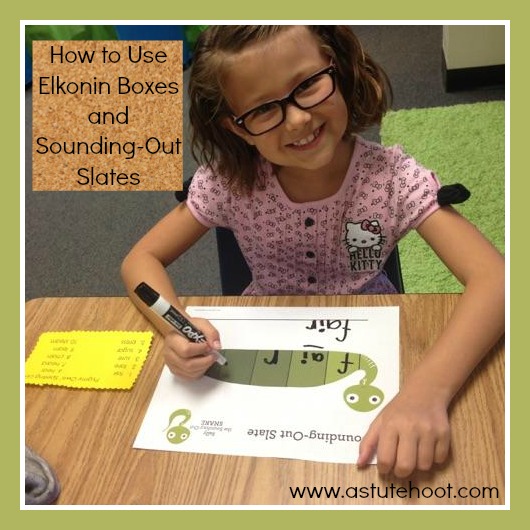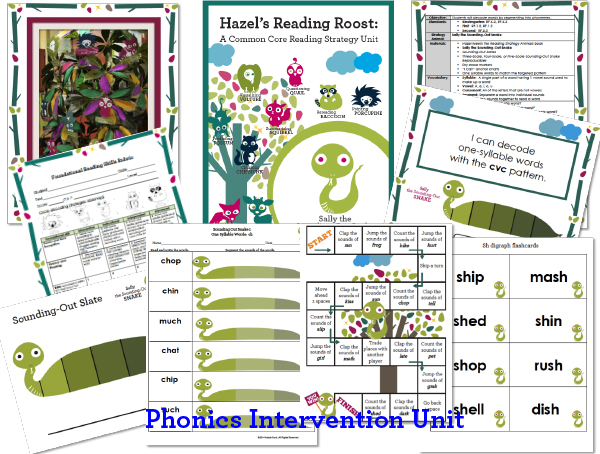How to Use Elkonin Boxes and Sounding-Out Slates
“I’m Sally the Sounding-Out Snake.
S-s-say, have you heard?
Stretch out all the sounds that you see in a word.
Blend sounds together, it’s really quite nice.
S-s-smooth out the words. That’s my advice.”

Sally the Sounding-Out Snake is one our decoding strategy animals in Hazel’s Reading Roost. Sally motivates students to practice critical early decoding skills. Read more about Sally’s strategy below…
WHAT is sounding-out? Sounding-out, or decoding, is the process of translating print into speech by rapidly matching a letter or combination of letters (graphemes) to their sounds (phonemes).
WHY is sounding-out important? Sounding-out, or decoding, is important because it is the foundation on which all other reading instruction builds. Proficient readers need to be able to segment words and hear individual phonemes in words. If students cannot decode words their reading will lack fluency, their vocabulary will be limited and they will struggle with reading comprehension.
HOW do I teach sounding-out? Explain that Sally helps readers decode unknown words by stretching the words out by sound and putting the sounds together to make a new word. Teach specific patterns to help students decode efficiently.
- CVC: Words with the consonant-vowel-consonant pattern (e.g., run, sad, beg, fit)
- Double consonants: Words with the double consonants f, l, s, or z pattern (e.g., puff, bell, kiss, fuzz)
- Vowel consonant –e: Words with a long vowel sound, spelled with one vowel and one consonant and a final silent e (e.g., date, bike, cone, rule)
- Blends: Words with a group of consonants whose sounds blend together (e.g., slim, flag, grip, crib)
- Digraphs: Words with a pair of letters representing a single speech sound such as sh, ch, th, wh (e.g., shed, chin, math, whip)
- Vowel –r: Words with the er, ir, or, ar, or ur pattern in which vowel pronunciation changes before /r/ (e.g., park, term, dirt, hurt)
Rather than teaching phonics patterns solely in isolation, integrate direct instruction with time for application of the skill in authentic literature. Practice many examples of each pattern to achieve mastery of that pattern before moving on to the next. In addition to using strategies such as dictation, marking words and flashcards, push students to find words with targeted patterns in literature and use those words in their writing.
We recommend using our Sally Sounding-Out Snake resources as a supplement to a research-based, multisensory phonic program that includes structured, explicit, systematic, cumulative instruction. Although we do not endorse a specific program, our students have demonstrated great success using the Wilson Language System and the Spalding Method. Read reviews of specific literary programs at What Works Clearinghouse.
WHEN should I use sounding out?
Explicit reading strategy instruction should be included in a balanced literacy program. Sally Sounding-Out Snake can be incorporated into various components of literacy lessons. Here are some specific examples of when to use Sally:
- Guided Reading: Introduce or review the sounding-out strategy by reading the Sally Sounding-Out Poem. Read aloud your selected guided reading text and model using a Sally Sounding-Out Slates to decode unknown words in context. Call on individual students to practice using Sally’s Slate with additional words. Encourage students to use Sally Sounding-Out Snake’s strategy when they are reading independently as well.
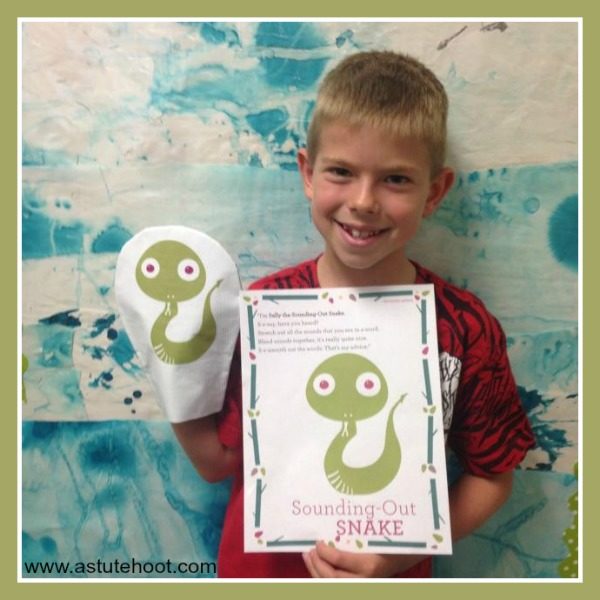
- Phonics Fun: Choose several one-syllable words from a weekly spelling list or phonics word study list. Guide students through verbally segmenting, or stretching out, the sounds of the word. Then have students write each individual sound (phoneme), in one of Sally’s scales on laminated Sally Sounding-Out Slates (see below). Last, students write the entire word on the line and blend the sounds together to read the entire word.
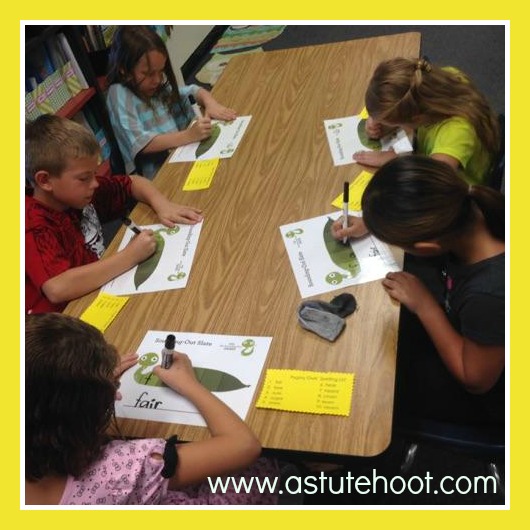
- Independent Practice: This unit contains a set of reproducibles for each phonics patterns, including sounding-out worksheets, flashcards and sentence writing practice. Copy and distribute appropriate materials for independent practice or homework activities. As an extension activity, direct students to find words with a specific pattern in authentic literature or leveled texts and record them on the Sounding-Out Snake reproducibles.
Helpful hints:
- Create a class set of Sally Sounding-Out Slates. Print slates onto cardstock using color printer and laminate. Distribute to class and explain specific procedures for using the slate (e.g., write one sound in each scale; no doodling, etc.). Use the slates to provide opportunities for strategy practice and application. They are perfect for spelling words, targeted phonics patterns or syllabication practice in a whole group, small group or one-on-one setting. These slates keep students actively engaged and serve as an informal assessment.
- Use the Sally Sounding-Out Slates as Elkonin Boxes. Elkonin boxes are an instructional method used in the early elementary grades to build phonological awareness by segmenting words into individual sounds. Each box represents one sound or phoneme of a word. On the Sally Sounding-Out Slate, each scale is a box. To use Elkonin boxes, a student listens to a word and moves a token into a box for each sound or phoneme. In some cases different colored tokens may be used for consonants and vowels or just for each phoneme in the word.
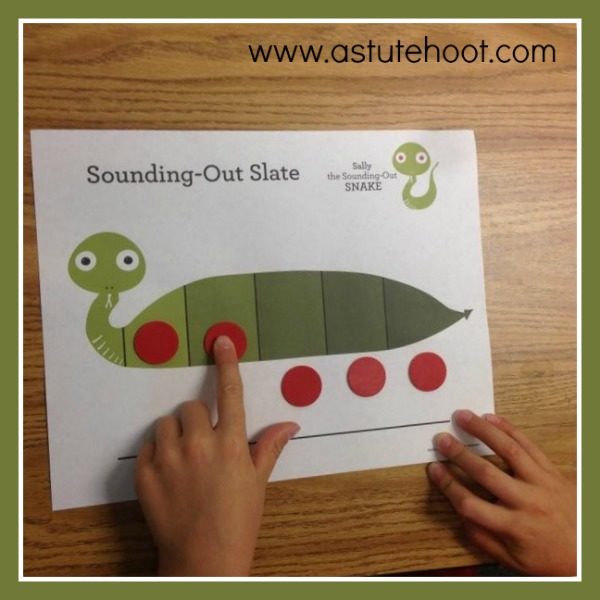
- Incorporate multisensory components. Introduce a variety of ways to segment or sound-out words.
- Visual: Using the Sally Sounding-Out Slate, have students draw a scoop under each scale, reading the sound (phoneme) aloud as they draw.
- Auditory: Prompt students to clap each part of the word to segment the phonemes as they say the word aloud.
- Tactile: Refer to the Elkonin box strategy listed above.
- Kinesthetic: Break apart the word and jump each sound or phoneme. Demonstrate how the number of jumps is equal to the number of sounds.
Sally’s unit is perfect for general education, special education, RTI and reading intervention. Download the complete unit here.


